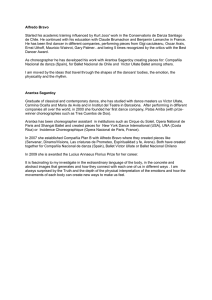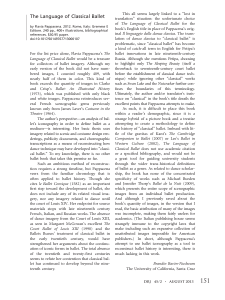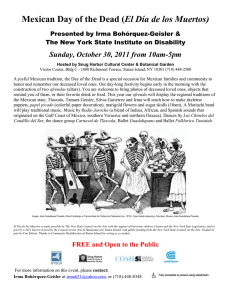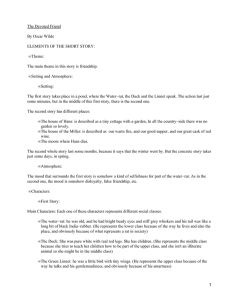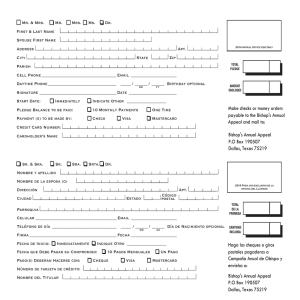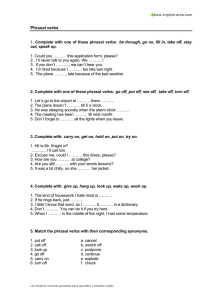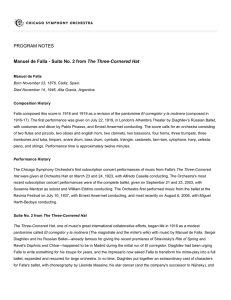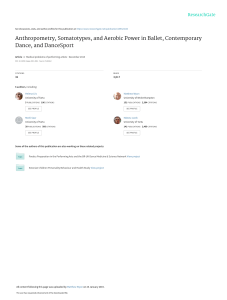581165-b2-first-for-schools-preparing-for-exam-success-self-study-reading-activities-part-1
Anuncio
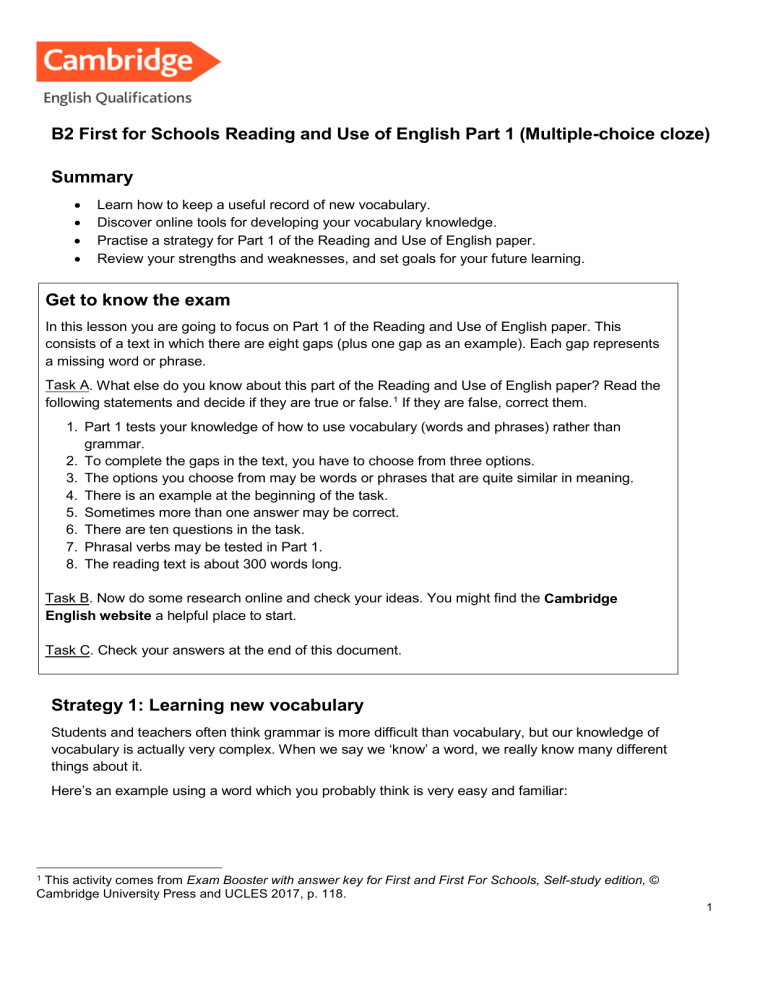
B2 First for Schools Reading and Use of English Part 1 (Multiple-choice cloze) Summary • • • • Learn how to keep a useful record of new vocabulary. Discover online tools for developing your vocabulary knowledge. Practise a strategy for Part 1 of the Reading and Use of English paper. Review your strengths and weaknesses, and set goals for your future learning. Get to know the exam In this lesson you are going to focus on Part 1 of the Reading and Use of English paper. This consists of a text in which there are eight gaps (plus one gap as an example). Each gap represents a missing word or phrase. Task A. What else do you know about this part of the Reading and Use of English paper? Read the following statements and decide if they are true or false. 1 If they are false, correct them. 1. Part 1 tests your knowledge of how to use vocabulary (words and phrases) rather than grammar. 2. To complete the gaps in the text, you have to choose from three options. 3. The options you choose from may be words or phrases that are quite similar in meaning. 4. There is an example at the beginning of the task. 5. Sometimes more than one answer may be correct. 6. There are ten questions in the task. 7. Phrasal verbs may be tested in Part 1. 8. The reading text is about 300 words long. Task B. Now do some research online and check your ideas. You might find the Cambridge English website a helpful place to start. Task C. Check your answers at the end of this document. Strategy 1: Learning new vocabulary Students and teachers often think grammar is more difficult than vocabulary, but our knowledge of vocabulary is actually very complex. When we say we ‘know’ a word, we really know many different things about it. Here’s an example using a word which you probably think is very easy and familiar: 1 This activity comes from Exam Booster with answer key for First and First For Schools, Self-study edition, © Cambridge University Press and UCLES 2017, p. 118. 1 head (n.) Spoken form: Just one syllable. Phonemic transcription: /hed/ The form(s) of this word Written form: Four letters. The /e/ sound is spelled ea. The meaning(s) of this word ‘Head’ has many meanings, including: • • • The use(s) of this word The physical part of an animal’s body, with eyes, ears, etc. The person who leads a team (‘the head of a company’). The part of a bed where I rest my head (‘the head of the bed’). It’s a countable noun, so could be used with the article ‘a’ or in plural form with numbers (‘3 heads’ etc.). When it describes a part of something larger, it’s followed by ‘of’. Sometimes it’s used as a verb or phrasal verb. (‘to head up an investigation’ = to lead an investigation). Create your own vocabulary flashcards To help you learn, understand and remember new vocabulary, you should make a note of details like these in your notebook. You could also make a small flashcard for each word, which you can use later to revise and test your memory. Let’s look at an example of a vocabulary flashcard. Imagine you’re creating a flashcard for the circled word in the text below. 2 The joy of photography Photography is a hobby with wide appeal. And I don't mean taking photos on your mobile phone, though it cannot be denied that such pictures can be surprisingly good these days. Serious photography means taking the trouble to do some research, exploring the technical aspects of the subject and investing in what might be quite expensive equipment. So why take up photography? Firstly… 1. Check the word in the online Cambridge Dictionary to find information about its spelling, pronunciation, meaning and use. 2. Complete the gaps in the flashcard on the next page. 2 Adapted from Exam Booster with answer key for First and First For Schools, Self-study edition, © Cambridge University Press and UCLES 2017, p. 13. 2 appeal (n.) Form Spoken: ___ syllables. Phonemic transcription: /_______/ Written: ea spelling sounds like ____ Meaning Definition: ________________________________________________________ Equivalent in my language: ___________________________________________ Use Common combinations with other words: _________________________________ Example sentence: ___________________________________________________ Tip! Pay attention to connotations and collocations. Connotations are the positive or negative associations that some words have. For example, the word ‘fat’ can describe a person whose weight is unhealthily high, but it has a very negative meaning. It’s more polite to call somebody ‘large’ or ‘heavy’. A doctor would probably say ‘overweight’. Collocations are words that you often see together. For example, ‘heavy rain’ or ‘light rain’, where the adjective describes how strongly the water is falling. Collocations like this can be very different in different languages and sometimes knowing which words collocate can help you choose the correct answer in the test. Finally, you’ll notice that some words have different meanings in different contexts. For example, we’ve just seen two meanings for the word ‘heavy’: one describes a person’s weight, and another describes the strength of rain. These are all things you can record in your vocabulary notebook to help make your knowledge of words much richer and improve your chances of test success! Research task 1: Online tools for vocabulary learning Many students like working on paper, but there are also many digital tools available to help you organise and revise new vocabulary. 1. Click here to learn about studying with Quizlet, which has both a website and mobile app where you can design your own vocabulary cards and play games to practise these words. 2. Now create a digital vocabulary card for the word ‘appeal’ that you studied above. Remember to include different aspects of meaning, use and form. 3 Reflect 1: Which way works for you? 1. Which version do you prefer – a paper flashcard or a digital flashcard? Why? 2. Which do you think will be more helpful for you when studying in future? Why? 3. Make some notes about these in your notebook. Now call or write to another student and tell Tip! Share your flashcards with other learners. It’s a good idea to collaborate when studying vocabulary. You can learn a lot from other students. You can also test each other and create activities for each other. This makes vocabulary learning more memorable and sometimes more enjoyable. Just be careful – check each other’s work with a dictionary or a teacher and make corrections if necessary! them what you think. Do they agree with you? Which approach works better for them? Why? Close-up: Understanding how this paper is designed Let’s look at how your vocabulary knowledge is tested in Part 1 of the Reading and Use of English paper. We’ll see how these tasks are designed, using a real text from a sample paper. 3 1. Read the text below. This is just the first half, and all the gaps are already filled out for you. You can also see the options for each gap below the text, so you can compare them. 2. What does the reader have to know about these words in order to choose the correct answer? Take some notes in your notebook. (You can use an online dictionary to help you.) The first one is done for you as an example to show you what you might write in your notebook. Ballet dancer by chance After five years of karate lessons, Hans Jensen, 13, (0) swapped his black belt for ballet shoes. Hans (1) gave his first public performance only a year ago when he danced in ‘The Nutcracker’ with the local dance school. Hans’s mother said ‘He was actually helping (2) out his little sister. She was very shy on stage until her brother was given a small part as a soldier. Hans enjoyed it so much that he (3) enrolled himself in ballet classes.’ 0 A swapped B varied C replaced D differed 1 A gave B showed C put D passed 2 A with B out C off D on 3 Text and task from Sample Test 1, D255/01. © UCLES 2015 Cambridge English Level 1 Certificate in ESOL International. 4 3 A enrolled B admitted C entered D introduced My notebook For gap 0, option A (‘swapped’) is best because: • The meaning of all four words is similar, but the use is different. • The whole text talks about a boy who first did karate and then changed to ballet. So the correct word probably means something about change or replacement. This means ‘varied’ and ‘differed’ are probably not right. • I can see ‘for’ in the text after ‘his black belt’. I know that ‘varied’ isn’t followed by a preposition, ‘differed’ is followed by ‘from’ and ‘replaced’ is followed by ‘with’ or ‘by’. • The correct structure is ‘swap something for something’, so the best answer is ‘swap’. Now read the whole text and complete the remaining gaps. Ballet dancer by chance After five years of karate lessons, Hans Jensen, 13, (0) swapped his black belt for ballet shoes. Hans (1) gave his first public performance only a year ago when he danced in ‘The Nutcracker’ with the local dance school. Hans’s mother said, ‘He was actually helping (2) out his little sister. She was very shy on stage until her brother was given a small part as a soldier. Hans enjoyed it so much that he (3) enrolled himself in ballet classes.’ Hans has already (4) _________ attention in the ballet world and recently won a scholarship to join the Royal Ballet School. He loves it there and is working hard to 5 increase his (5) _________ of dance steps. ‘I want to become stronger, (6) _________ experience and learn as much as I can,’ he said. His teacher, Yevgen Gregorevic, who has danced professionally in a variety of lead (7) _________, said, ‘Hans has natural ability and always works hard.’ Hands has (8) _________ himself the goal of one day dancing for the Bolshoi Ballet. 0 A swapped B varied C replaced D differed 1 A gave B showed C put D passed 2 A with B out C off D on 3 A enrolled B admitted C entered D introduced 4 A paid B achieved C taken D attracted 5 A range B volume C total D scale 6 A collect B raise C add D gain 7 A posts B jobs C roles D places 8 A set B thought C decided D put Research task 2: Create your own task Now you understand how the exam works, it’s time to change places – you are going to write your own task for Part 1 of the Reading and Use of English paper! 1. Find a short reading text online which interests you. 2. Use it to make a ‘mini version’ of a Part 1 gapped text: o Use just 50-100 words of the text. o Include a title which clearly reflects the topic of this shortened text. o Remove 3–4 words from the text. Choose them carefully so it seems possible to put another word in this gap. o Write 1 or 2 alternatives for each gap. Make sure these alternatives are not possible (because they have a different meaning or because they are used differently). o Keep the original text so you have an answer key! Your finished task should look like the first part of the text (‘Ballet dancer by chance’) above. 3. Send the gapped text to another student or friend and ask them to choose the best word for each gap. Ask them to think about their choices, as you might ask them later to explain these. 4. Check their answers, give them feedback and discuss the task together. What did they have trouble with? Why? 5. Take some notes about this activity in your notebook – it may help you in future to remember what you and other students found difficult, as well as any mistakes you should avoid. 6 Strategy 2: How to approach the exam You don’t have a lot of time to do Part 1 of the Reading and Use of English paper, so you need an efficient strategy. Here’s one approach that works for many learners: Step: Why do this? Why do it in this order? 1. Read the title. These two steps will tell you the main topic and style of the text. It’s important to understand what the whole text is about, because sometimes meaning is communicated by more than just individual words or sentences. 2. Read the whole text in about 2–3 minutes. 3. Look at each gap. Look at what comes before it and after it. Sometimes only one word is possible in a particular phrase or structure. This is partly about meaning, but also about use. For example, some verbs are always followed by certain prepositions (like depend on). If the four options have similar meanings, you might be able to choose the correct one by considering how each one is used. 4. Guess the missing word(s). Sometimes we surprise ourselves with how much we already know! You might find that something just ‘feels right’ or ‘sounds right’ when you first look at a gap. Looking at the options first can be distracting and make you doubt your first instincts. And research shows that we make our memories stronger when we test them – so it’s a good idea to develop your memory by thinking first and looking at options second. 5. Now look at the four options and choose the best one. Now try using this strategy for the practice task below. 7 Exam practice: Reading and Use of English Part 1 (Multiple-choice cloze) Great work! You know a lot about how vocabulary is learned and about how the test is designed. You’re ready to practise a real test now. When you have finished, check your answers at the end of the document and do the final reflection task below. 8 Source: Sample Test 2. © UCLES 2015 Cambridge English Level 1 Certificate in ESOL International. Reflect 2: How can you keep improving your vocabulary knowledge? 1. Which aspects of learning vocabulary and taking this test do you find easiest? Tick the items in the following list that you feel most confident about: o o o o o o o o Understanding the meaning of a word from context Knowing how to pronounce a word Knowing how to spell a word Knowing which words to use together (like prepositions) Remembering the parts of phrasal verbs Remembering the different meanings of similar phrasal verbs Finding an equivalent word in my own language Not spending too much time on this part of the test 2. How can you develop your abilities in the other areas? Write some ideas in your notebook, then check the suggested activity at the end of the answer key (see below). 9 Answer key Get to know the exam 1. Part 1 tests your knowledge of how to use vocabulary (words and phrases) rather than grammar. [True.] 2. To complete the gaps in the text, you have to choose from three options. [False. There are four options for each gap.] 3. The options you choose from may be words or phrases that are quite similar in meaning. [True.] 4. There is an example at the beginning of the task. [True.] 5. Sometimes more than one answer may be correct. [False. Only one answer is correct.] 6. There are ten questions in the task. [False. There are eight questions in Part 1 of this paper.] 7. Phrasal verbs may be tested in Part 1. [True.] 8. The reading text is about 300 words long. [False. It is about 160 words long.] Strategy 1: Learning new vocabulary appeal (n.) Form Spoken: 2 syllables. The second syllable is stressed: app-EAL. Phonemic transcription: /əˈpiːl/ Written: ea spelling sounds like /iː/ as in ‘eat’ Meaning Definition: the quality in someone or something that makes it attractive or enjoyable. (It has other meanings, but this is the meaning I learned in the text about photography.) Related words: appealing (adj.), to appeal (v.) Equivalent in my language: attrait Use [this is what a French speaker might write] Common word combinations: unique appeal, great appeal, wide appeal, the appeal of something Example sentences: Photography is a hobby with wide appeal. I've never understood the appeal of skiing. 10 Close-up: Understanding how this paper is designed Ballet dancer by chance After five years of karate lessons, Hans Jensen, 13, (0) swapped his black belt for ballet shoes. Hans (1) gave his first public performance only a year ago when he danced in ‘The Nutcracker’ with the local dance school. Hans’s mother said, ‘He was actually helping (2) out his little sister. She was very shy on stage until her brother was given a small part as a soldier. Hans enjoyed it so much that he (3) enrolled himself in ballet classes.’ 0 A swapped B varied C replaced D differed 1 A gave B showed C put D passed 2 A with B out C off D on 3 A enrolled B admitted C entered D introduced 1. Option A (‘gave’) is correct because: o It’s the only verb which goes with ‘performance’ in this context. o ‘Put’ also works, but only if we add ‘on’: ‘put on a performance’. So it’s not possible here. o ‘Showed’ has a similar meaning but ‘showed a performance’ isn’t a collocation which means that an individual person (or group of people) performed. It might mean that a cinema or theatre did something. o ‘Passed’ does not mean anything in this context. 2. Option B (‘out’) is correct because: o ‘Help’ isn’t used in phrasal verbs with ‘on’ or ‘off’. o ‘Help’ and ‘help out’ have a similar meaning, and both would be followed by ‘with’, but the structure is different: help + his little sister + with + a task/job/problem o o help out + his little sister + with + a task/job/problem help + his little sister + out + with + a task/job/problem In this case, the words ‘his little sister’ come immediately after the gap. The word ‘with’ must always come after the words ‘his little sister’. This means ‘with’ is not possible here. Only ‘out’ is possible. 11 3. Option A (‘enrolled’) is correct because: o ‘Admitted himself’ has a similar meaning but isn’t used for joining a class. It’s used for acceptance into a medical institution (such as a hospital) or being allowed to enter a place for a performance, usually with a ticket (for example, ‘admitted to the cinema’). It should also be followed with ‘into’, not ‘in’. o ‘Entered himself’ has a similar meaning and is followed by ‘in’ but isn’t used for joining a class. It’s used for submitting an application to participate in a competitive event (for example, ‘He entered himself in the sports competition’). o ‘Introduced himself’ does not have a similar meaning. ‘He introduced himself’ means he said ‘Hello, my name is Hans.’ o Only ‘…enrolled himself in…’ means that he decided and formally asked (and maybe paid) to join a class. Answers to rest of this task (‘Ballet dancer by chance’): 4 D attracted 5 A range 6 D gain 7 C roles 8 A set Exam practice: Reading and Use of English Part 1 (Multiple-choice cloze) ‘Hunting for dinosaurs’ 1 C turned 2 B gathered 3 A conditions 4 D exposed 5 D remains 6 B donated 7 C chance 8 A disapprove Reflect 2: an idea for question 2 1. Find reading material that interests you. Just read it and tell someone about it. 2. Now go back and read it again and note down any useful vocabulary and how it is used. 3. Now tell someone about it in English, using some of this vocabulary. For example, you could call a friend or email another student. 12
